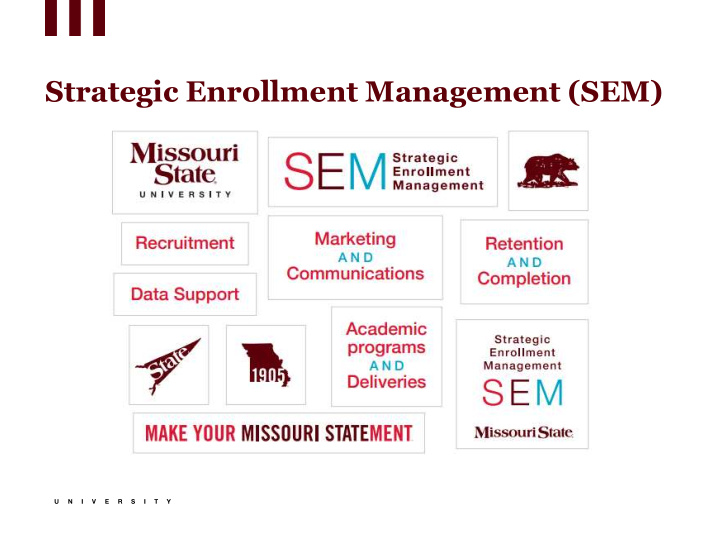



Strategic Enrollment Management (SEM)
What is SEM? Strategic enrollment management (SEM) is a key concept in the administration of higher education institutions today. SEM provides a unique framework for improving student and institutional outcomes by jointly enabling student access to and success in higher education , best business practices, and comprehensive institutional planning . (AACRAO) Strategic enrollment management [SEM] is a crucial element of planning for new growth at a university or college as it concerns both academic program growth and facilities needs . SEM focuses on what is best for students' success while increasing enrollment numbers and stabilizing institutional revenues . (Wikipedia) Strategic enrollment planning is more than a long-term recruitment or retention plan. It is a data-informed process that aligns an institution’s fiscal, academic, co-curricular, and enrollment resources with its changing environment to accomplish the institution’s mission and ensure the institution’s long-term enrollment success and fiscal health . (Ruffalo Noel Levitz)
The Four Components of Enrollment Management •Recruitment •Retention •Research •Structure
Developing a SEM Plan • Incorporate best practices • Requires campus collaboration • Faculty involvement • Student perspective • Institutional knowledge with fresh ideas • Strategic • Enrollment • Fiscal planning • Capacity management • Student services and success • Etc. • Long term and NOW
MSU SEM Structure • BOG Senior leadership Steering Committee, Four councils Data Support Team Subcommittees • Co-chair model • Faculty involvement • Use of SEM goals • Dual purpose • Reassess structure and membership after SEM plan is developed • Subcommittee development and opportunities
Missouri State SEM Committee Structure Senior Leadership Clif Smart, President; Dr. Frank Einhellig, Provost; Dr. Dee Siscoe, Vice President for Student Affairs. Overall management of SEM process and communication with Board of Governors SEM Steering Committee Long-term enrollment goals, securing the approval of strategies through appropriate institutional channels, communication with President and Administrative Council Recruitment Council Academic Programs and Marketing and Retention and Completion Develop strategic goals and Deliveries Council Communications Council Council action plans for new student Develop strategic goals and Develop strategic goals and Develop strategic goals and recruitment and outreach action plans regarding the action plans to raise the profile action plans for retention and development and alignment of of the University via both internal graduation academic programs and and external marketing and deliveries that meet the demands communication of current students Community Ad Hoc Sub- Ad Hoc Sub- Involvement Committees as Committees as Subcommittee needed needed Data Support Team Environment scanning, student enrollment behavior research, enrollment models, provide data to councils as needed
Steering Committee Members First Name Last Name Area 1 Rob Hornberger (co-chair) Enrollment Management 2 Tammy Jahnke (co-chair) CNAS 3 Brad Bodenhausen * International Services 4 Jeff Coiner Information Services 5 Tom Dicke CHPA, Past Faculty Senate Chair 6 Lahi Dirie SGA 7 Steve Foucart Financial Services 8 Julie Masterson * Graduate College 9 Saibal Mitra CNAS, Faculty Senate Chair 10 Wes Pratt Diversity and Inclusion 11 Suzanne Shaw Marketing and Communications 12 Christina Simmers* COB 13 Kelly Wood * Center for Academic Success and Transition *Also a subcommittee co-chair
Council Chairs First Name Last Name Area Recruitment Council Brad Bodenhausen (co-chair) International Programs Nechell Bonds (co-chair) Admissions (undergraduate) Retention and Completion Council Michele Smith (co-chair) Student Affairs and Multicultural Services Kelly Wood (co-chair) Center for Academic Success and Transition Academic Programs and Deliveries Council Julie Masterson (co-chair) Graduate College Dave Meinert (co-chair) COB Marketing and Communications Council Stacey Funderburk (co-chair) Marketing and Communications Christina Simmers (co-chair) COB Data Support Team Theresa McCoy (co-chair) Computer Services Michelle Olsen (co-chair) Institutional Research Community Involvement Subcommittee Rachelle Darabi (co-chair) Provost’s Office, Center for Community Engagement Brent Dunn (co-chair) Advancement
SEM Goals/Guiding Principles • Stabilize enrollment short term • Grow enrollment in targeted areas • Improve retention • Facilitate successful degree and credential completion • Broaden access to underserved populations • Identify new and emerging academic programing that meets student and workforce demands • Equip students for successful career outcomes • Employ actions and modify processes that eliminate barriers that impair student success. • Raise the profile of the University • Develop a culture of enrollment growth among faculty, staff, and students
Timeline Due Item End of fall 2019 semester Progress reports from councils March 1, 2020 Council drafts of objectives and strategies due April 1, 2020 Steering Committee SEM plan draft due June 1, 2020 Steering Committee SEM plan final due
Pre-established Subcommittees PLENTY OF OPPORTUNITIES FOR INVOLVEMENT!!! • Alternative Credentials • Community Involvement • Dual credit • Financials and scholarships • Innovation • Non-traditional Students • Online • Orientations • Transfer students • MORE
Breakout Sessions • Recruitment Council, Room D • Retention and Completion Council, Room E • Academic and Deliveries Council, Room F • Marketing and Communications Council Room, 118 • Data Support Team, Main room back (C) • Community Involvement Subcommittee, Room 108 • Other Stakeholders, Main room stage side (A)
Recommend
More recommend